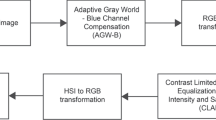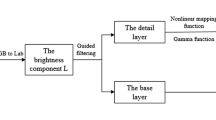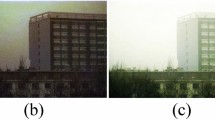Abstract
The study of sand-dust images has made remarkable progress in recent years. However, it is challenging to balance the image quality, color casts correction, and running time well in the existing sand-dust image processing methods. This paper introduces a novel compensation coefficient and effective intensity difference prior, which leads to an efficient and robust sand dust removal method. This method assumes that the medium transmission coefficients of each pixel are not equal. First, the rough transmission is estimated by the red-green channel pixel-wise, thereby leading to significantly reduced running time. Then, the difference between the blue channel and red-green channel is utilized to compensate for the rough transmission. Besides, ambient light is estimated using the minimum absolute intensity difference between channels, according to the attenuation characteristics of light in sand dust. Meanwhile, a color adjustment method based on global stretch and the green channel is also improved, making the method effective on various sand-dust images. A series of experiments are conducted on a number of challenging sand-dust images with the proposed method and other state-of-the-art sand dust removal techniques, revealing the superiority of the proposed method in terms of calculation time, color shift correction, and restoration quality over all the comparable techniques.









Similar content being viewed by others
References
Achanta SDM, Karthikeyan T, Vinothkanna R (2019) A novel hidden markov model-based adaptive dynamic time warping (hmdtw) gait analysis for identifying physically challenged persons. Soft Comput 23(18):8359–8366
Al-Ameen Z (2016) Visibility enhancement for images captured in dusty weather via tuned tri-threshold fuzzy intensification operators. Int J Intell Syst Applic 8(8):10
Alruwaili M, Gupta L (2015) A statistical adaptive algorithm for dust image enhancement and restoration. In: 2015 IEEE International conference on electro/information technology (EIT), IEEE, pp 286–289
Li C, Liu H, XLC, Pan ZR (2018) Enhancement algorithm of dust image based on multi-perceptual feature calculation. Journal of Lanzhou University of Technology 4
Cai B, Xu X, Jia K, Qing C, Tao D (2016) Dehazenet: An end-to-end system for single image haze removal. IEEE Trans Image Process 25(11):5187–5198
Carlevaris-Bianco N, Mohan A, Eustice RM (2010) Initial results in underwater single image dehazing. In: Oceans 2010 mts/IEEE seattle, IEEE, pp 1–8
Chen BH, Huang SC (2013) Improved visibility of single hazy images captured in inclement weather conditions. In: 2013 IEEE International symposium on multimedia, IEEE, pp 267–270
Chen WT, Fang HY, Ding JJ, Kuo SY (2020) Pmhld: Patch map-based hybrid learning dehazenet for single image haze removal. IEEE Trans Image Process 29:6773–6788
Cheng Y, Jia Z, Lai H, Yang J, Kasabov NK (2020) Blue channel and fusion for sandstorm image enhancement. IEEE Access 8:66931–66940
Cheng Y, Jia Z, Lai H, Yang J, Kasabov NK (2020) A fast sand-dust image enhancement algorithm by blue channel compensation and guided image filtering, vol 8
Darwante S, Kadam A, Talele H, Ade O, Bankar A (2019) Border surveillance monitoring application. In: 2019 5Th international conference on computing, communication, control and automation (ICCUBEA), IEEE, pp 1–6
Fattal R (2008) Single image dehazing. ACM Transactions on Graphics (TOG) 27(3):1–9
Fu X, Huang Y, Zeng D, Zhang XP, Ding X (2014) A fusion-based enhancing approach for single sandstorm image. In: 2014 IEEE 16Th international workshop on multimedia signal processing (MMSP), IEEE, pp 1–5
Gao G, Lai H, Jia Z, Liu Y, Wang Y (2020) Sand-dust image restoration based on reversing the blue channel prior. IEEE Photonics Journal 12 (2):1–16
Gao G, Lai H, Liu Y, Wang L, Jia Z (2021) Sandstorm image enhancement based on yuv space. Optik 226:165659
Hautiere N, Tarel JP, Aubert D, Dumont E (2008) Blind contrast enhancement assessment by gradient ratioing at visible edges. Image Analysis & Stereology 27(2):87–95
He K, Sun J, Tang X (2010) Guided image filtering. In: European conference on computer vision, Springer, pp 1–14
He K, Sun J, Tang X (2010) Single image haze removal using dark channel prior. IEEE Trans Pattern Anal Mach Intell 33(12):2341–2353
Huang SC, Chen BH, Wang WJ (2014) Visibility restoration of single hazy images captured in real-world weather conditions. IEEE Trans Circuits Syst Video Technol 24(10):1814–1824
Huang SC, Ye JH, Chen BH (2014) An advanced single-image visibility restoration algorithm for real-world hazy scenes. IEEE Trans Ind Electron 62(5):2962–2972
Kasabov NK (2019) Time-space, spiking neural networks and brain-inspired artificial intelligence. Springer
Khodayari-Rostamabad A, Reilly JP, Nikolova NK, Hare JR, Pasha S (2009) Machine learning techniques for the analysis of magnetic flux leakage images in pipeline inspection. IEEE Transactions on Magnetics 45(8):3073–3084
Kim SE, Park TH, Eom IK (2019) Fast single image dehazing using saturation based transmission map estimation. IEEE Trans Image Process 29:1985–1998
Levin A, Lischinski D, Weiss Y (2007) A closed-form solution to natural image matting. IEEE Trans Pattern Anal Mach Intell 30(2):228–242
Li M, Liu J, Yang W, Sun X, Guo Z (2018) Structure-revealing low-light image enhancement via robust retinex model. IEEE Trans Image Process 27(6):2828–2841
Mittal A, Soundararajan R, Bovik AC (2013) Making a “completely blind” image quality analyzer. IEEE Signal Process Lett 20(3):209–212
Zhi N, SJM, Li M (2016) Visibility restoration algorithm of sand dust degraded images. Journal of Image and Graphics 21(12):1585–1592
Narasimhan SG, Nayar SK (2000) Chromatic framework for vision in bad weather. In: Proceedings IEEE conference on computer vision and pattern recognition. CVPR 2000 (Cat. No. PR00662), vol 1, IEEE, pp 598–605
Park TH, Eom IK (2021) Sand-dust image enhancement using successive color balance with coincident chromatic histogram. IEEE Access 9:19749–19760
Peng YT, Cao K, Cosman PC (2018) Generalization of the dark channel prior for single image restoration. IEEE Trans Image Process 27(6):2856–2868
Peng YT, Cosman PC (2016) Single image restoration using scene ambient light differential. In: 2016 IEEE International conference on image processing (ICIP), IEEE, pp 1953–1957
Peng YT, Lu Z, Cheng FC, Zheng Y, Huang SC (2019) Image haze removal using airlight white correction, local light filter, and aerial perspective prior. IEEE Trans Circuits Syst Video Technol 30(5):1385–1395
Ren D, Shang W, Zhu P, Hu Q, Meng D, Zuo W (2020) Single image deraining using bilateral recurrent network. IEEE Trans Image Process 29:6852–6863
Shi Z, Feng Y, Zhao M, Zhang E, He L (2019) Let you see in sand dust weather: A method based on halo-reduced dark channel prior dehazing for sand-dust image enhancement. Ieee Access 7:116722–116733
Shi Z, Feng Y, Zhao M, Zhang E, He L (2019) Normalised gamma transformation-based contrast-limited adaptive histogram equalisation with colour correction for sand–dust image enhancement. IET Image Process 14 (4):747–756
Tan RT (2008) Visibility in bad weather from a single image. In: 2008 IEEE Conference on computer vision and pattern recognition, IEEE, pp 1–8
Wang B, Wei B, Kang Z, Hu L, Li C (2021) Fast color balance and multi-path fusion for sandstorm image enhancement. SIViP 15(3):637–644
Wang J, Pang Y, He Y, Liu C (2016) Enhancement for dust-sand storm images. In: International conference on multimedia modeling, Springer, pp 842–849
Wang Y, Li Y, Zhang T (2010) The method of image restoration in the environments of dust. In: 2010 IEEE International conference on mechatronics and automation, IEEE, pp 294–298
Wang Y, Li Y, Zhang T (2010) Study on the method of image restoration in the environment of dust. In: 2010 6Th international conference on wireless communications networking and mobile computing (wiCOM), IEEE, pp 1–4
Xu G, Wang X, Xu X (2020) Single image enhancement in sandstorm weather via tensor least square. IEEE CAA J Autom Sinica 7(6):1649–1661
Yan T, Wang L, Wang J (2014) Method to enhance degraded image in dust environment. J Softw 9(10):2672–2677
Yan Y, Chen G (2017) Single image visibility restoration using optical compensation and pixel-by-pixel transmission estimation. J Commun 38 (5):48
Yang Y, Zhang C, Liu L, Chen G, Yue H (2020) Visibility restoration of single image captured in dust and haze weather conditions. Multidim Syst Sign Process 31(2):619–633
Yu S, Zhu H, Wang J, Fu Z, Xue S, Shi H (2016) Single sand-dust image restoration using information loss constraint. J Mod Opt 63(21):2121–2130
Zeng W, Fu CW, Arisona SM, Erath A, Qu H (2014) Visualizing mobility of public transportation system. IEEE Transactions on Visualization and Computer Graphics 20(12):1833–1842
Acknowledgements
This work was supported by the International Science and Technology Cooperation Project of the Ministry of Education of the People’s Republic of China under Grant DICE 2016–2196, the National Natural Science Foundation of China under Grant U1803261, scientific research plan of universities in Xinjiang Uygur Autonomous Region under grant XJEDU2019Y006, and the Natural Science Foundation of XinJiang under Grants 2021D01C057. We sincerely thank the editors and reviewers for taking the time to review our manuscript.
Author information
Authors and Affiliations
Corresponding author
Ethics declarations
Conflict of Interests
The authors declare that they have no conflict of interest.
Additional information
Publisher’s note
Springer Nature remains neutral with regard to jurisdictional claims in published maps and institutional affiliations.
Appendix
Appendix
Rights and permissions
About this article
Cite this article
Shi, F., Jia, Z., Lai, H. et al. Sand-dust image enhancement based on light attenuation and transmission compensation. Multimed Tools Appl 82, 7055–7077 (2023). https://doi.org/10.1007/s11042-022-13118-1
Received:
Revised:
Accepted:
Published:
Issue Date:
DOI: https://doi.org/10.1007/s11042-022-13118-1




